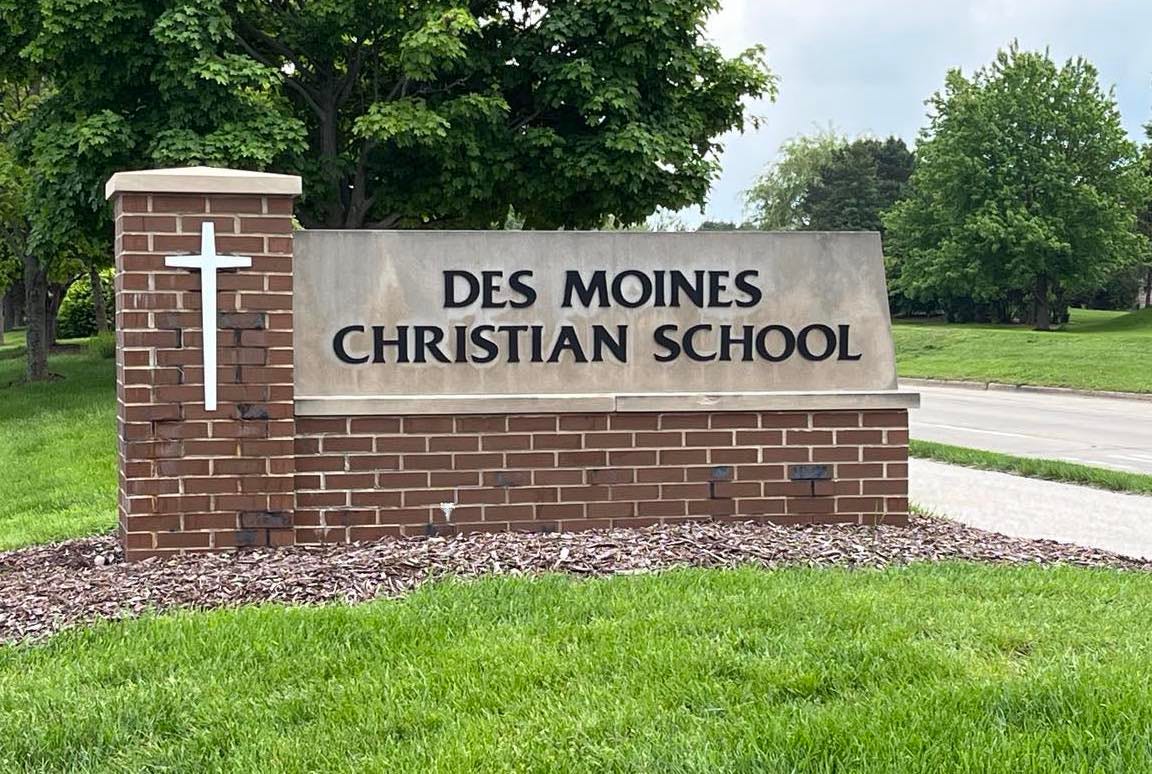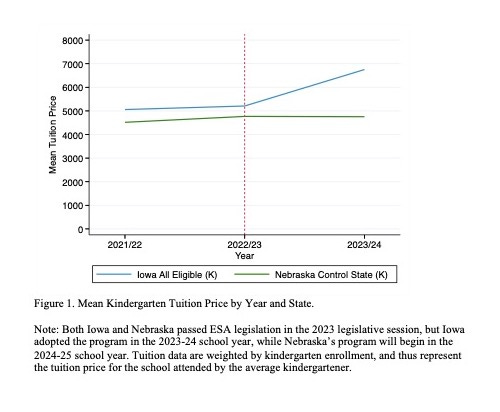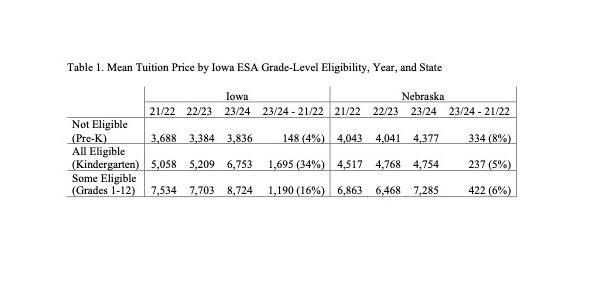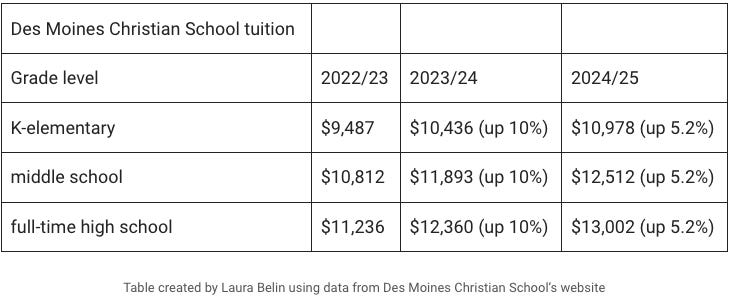This post is part of the Iowa Writers Collaborative and is an updated version of an article first published at Bleeding Heartland. For regular emails linking to all recent Bleeding Heartland articles and commentary, including more coverage of education, state government and the Iowa legislature’s 2024 session, subscribe to the free Evening Heartland newsletter. If your email provider truncates this post, you can read the whole article without interruption at this link.
A comprehensive academic study found “causal evidence” that Governor Kim Reynolds’ Education Savings Accounts policy (commonly known as school vouchers) “led Iowa private schools to increase tuition” during its first year.
Princeton University doctoral student Jason Fontana and Princeton sociology Professor Jennifer L. Jennings published their working paper, “The Effect of Taxpayer-Funded Education Savings Accounts on Private School Tuition: Evidence from Iowa,” at Brown University’s Annenberg Institute in April.
Fontana and Jennings collected tuition data from 70 percent of Iowa’s private schools, focusing their analysis on 51 percent of schools (educating 62 percent of Iowa students attending private schools) for which they had multiple years of tuition data as well as grade-level enrollment numbers.
The researchers compared private school tuition in Iowa and Nebraska. Both states enacted taxpayer-funded “school choice” policies in 2023, but Iowa implemented Education Savings Accounts for the 2023/2024 school year, while Nebraska delayed its start date until 2024/2025.
“ELIGIBLE GRADES EXPERIENCE SIGNIFICANT INCREASES IN TUITION”
Critics warned early last year that private schools would likely jack up tuition once state funds began flowing. Before long, anecdotes emerged to back up those suspicions. Ty Rushing reported for Iowa Starting Line in May 2023 that at least fifteen private schools across Iowa had approved tuition hikes.
The new working paper lends analytical heft to that debate. Fontana and Jennings found “Eligible grades experience significant increases in tuition following Iowa’s ESA implementation. We observe no such patterns for Nebraska schools.”
Figure 1 from their paper compares kindergarten tuition in the Iowa schools studied with the Nebraska schools in their dataset (44 percent of that state’s private schools educating 51 percent of Nebraska students enrolled in a private school).
FAMILIES “MAY BE PRICED OUT OF SCHOOLS”
Research by Fontana and Jennings also suggests the trend toward higher tuition could accelerate as income limits for Iowa’s program disappear in the third year of operation.
Iowa’s ESAs were open to all kindergartners from the beginning. Students in grades 1-12 could qualify if their family income did not exceed 300 percent of the federal poverty level in the first year or 400 percent of the federal poverty level for 2024/2025. Starting with the 2025/2026 school year, every K-12 private school student in Iowa will be eligible for school vouchers, even if their family income is in the top 1 percent.
Fontana and Jennings found that tuition increased by a larger percentage where more students were eligible for ESA funds.
When eligibility was universal (kindergarten), private schools increased prices 21-25%, compared with 10-16% in grades with partial eligibility. In contrast, private schools did not increase tuition in pre-K, which was ineligible for ESAs.
Table 1 from their working paper shows the difference in mean tuition price by grade level.
Reynolds has repeatedly claimed her plan would reduce financial barriers to attending private school. She promised during her 2023 Condition of the State address that when the program was fully phased in, “no child will be limited by income or zip code.”
However, tuition hikes can keep private school out of reach for families who lack the means to cover costs exceeding the value of an ESA ($7,635 for the current school year, $7,826 for 2024/2025). Even if the ESA funds fully cover private school tuition, they can’t be used for some related expenses that could be a barrier for lower-income families, such as transportation, school uniforms, and child care before or after school.
“If a goal of ESAs is to extend private school access to new families,” Fontana and Jennings write, “the substantial tuition increases they produce may limit access.”
Des Moines Christian School in Urbandale, among Iowa’s largest private schools, illustrates how the problem could play out. To create this table, I used the Wayback Machine for tuition rates for 2022/2023 and 2023/2024, and retrieved the 2024/2025 rates from the school’s website.
Note that state funding for each student’s ESA will increase by 2.5 percent from $7,635 for the current school year to $7,826 for 2024/2025, matching the increase in per-pupil state funds for K-12 public schools. However, Des Moines Christian’s tuition is going up by 5.2 percent next year, even though the school’s tuition already exceeded the ESA amount. That will make it even less affordable for lower-income families.
While Des Moines Christian claims one in five of enrolled students “receive tuition assistance,” it’s not clear how much of a discount they receive. In any event, the school’s own reported data indicates that 80 percent of the student body have families that can afford the full tuition plus associated fees, without any taxpayer help.
Kathy Bolten reported for the Des Moines Business Record on May 15 that the Des Moines Christian School Association has paid $6.8 million to buy 100 acres about one mile north of its campus. The school, which “had 89 high school graduates in 2023,” plans to build a new high school on the purchased land. Enrollment will be able to expand considerably once grades 9-12 have a separate facility, costing taxpayers more every year.
Fontana and Jennings write,
Iowa’s ESA program’s expressed purpose was to increase access to “the school best suited” for a child, “regardless of zip code or income” (Office of Governor Reynolds 2023). To the extent tuition levels outpace the ESA payment, families unable to further contribute to tuition may be priced out of schools, thus defeating the program’s stated goal. If this is the case, ESAs act as tuition subsidies for families who can already afford private school. Future work should consider to what extent tuition increases limit families’ options.
When Republicans fast-tracked the governor’s voucher plan in January 2023, public school advocates and many Democratic legislators predicted that very scenario: “tuition subsidies for families who can already afford private school.”
Total costs for Iowa’s school choice program are escalating even faster than private school tuition hikes. The nonpartisan Legislative Services Agency has estimated the state will spend just under $128 million on ESAs during the current fiscal year. On the last day of the 2024 legislative session, Republicans in the Iowa House and Senate approved a “standings” appropriations bill that projected spending $179 million on ESAs during fiscal year 2025, which begins on July 1. Those numbers far exceed the program’s initial cost estimates.
Once income limits go away in fiscal year 2026, school choice will cost Iowa taxpayers more than $300 million each year. It’s not yet clear how many new private schools will pop up to take advantage of the easy money. Republican State Representative Dean Fisher is board president of one such Christian school, which hopes to begin instruction in Tama County in August 2025.
GOVERNOR ASSERTS PRIVATE SCHOOLS ARE “ACCESSIBLE TO EVERYBODY”
During a May 17 media availability, KCCI-TV’s Amanda Rooker asked Reynolds what her administration is doing to track private school tuition and determine whether the ESA program is successful. Reynolds replied, “Well, first of all, it’s going to be about outcomes. It’s ultimately about giving parents a choice in their child’s education and letting them be in charge of it, and letting them decide what’s the best place for their child to receive a quality education.”
It’s important to understand that private schools are not required to enroll all willing students. Many reject those with special needs, for example. Public schools must serve every child in the district.
Reynolds went on to discuss the money “that travels with the student” when they decide to attend a private school. She said that “just like our public schools do,” private schools have to assess teacher salaries and operational costs to determine how to “continue to grow, continue to keep their educators with their school, continue to be a viable option.” She compared it to public schools asking for an increase in state supplemental aid.
One key difference is that public schools are locked into whatever funding the Republican-controlled legislature approves, whereas private school boards can adopt tuition hikes at any level to cover costs. Per pupil state funding for public K-12 schools hasn’t kept pace with inflation for more than a decade. It increased by 3 percent for the 2023/2024 academic year and will go up by 2.5 percent for the coming year.
Costs are rising for schools everywhere, yet Fontana and Jennings found significantly larger tuition increases for private schools in Iowa compared to Nebraska, where state-funded ESAs were not yet operating.
Reynolds told reporters on May 17 that when weighing the impact of the ESA program, she would consider “accessibility”:
We wanted all families to have that opportunity. We’ll look at the number of schools that are either below the $7,400 or at the $7,400. And if the majority of the students are—land there, with the average statewide cost, then it’s not an accessibility issue. They are accessible to everybody, and it’s not costing them any more money.
When the governor mentioned $7,400, she appeared to be referring to the amount awarded to each student who qualifies for an ESA. As noted above, that figure was $7,635 for the program’s first year and will be $7,826 for the coming year.
Reynolds acknowledged that some schools are charging more than the ESA amount for tuition, adding,
You have to also look at capacity. So, do they have open seats, or do they have a huge wait list? And if they have a wait list, then individuals have decided for that school, that they’re willing to pay—families—a little bit more to go to that school. And they don’t really need to incentivize it, because they have a wait list.
So they have to make decisions on, do we grow, or do we expand, or do we maybe raise a little bit more and continue to keep the tuition where it is.
But all of those need to be taken into account and should be looked at if you’re going to do any kind of comparison about the impact of ESAs on accessibility and public schools. Because those are things that define if it’s an issue or not.
And I think—the last report I saw, the average tuition for kindergarten was like 600 dollars below the $7,400. And so parents can not only go, not have any out of pocket expenses, but can use some of that for books and other things that are eligible for an ESA.
Remember, ESA funds can’t be used for all costs associated with attending a private school. Also, tuition costs tend to increase at higher grade levels. So if the average for kindergarten is only $600 below the voucher amount, many private schools must be charging significantly more than the ESA value for older students.
The governor’s word salad did not address the central issue: schools charging more than students can receive in an ESA will not be accessible to low-income families and may not be affordable for middle-class families either.
Reynolds and her Department of Education will have incentives to declare ESAs a success regardless of the facts on the ground. Further academic research will be essential to understanding whether “school choice” has benefited Iowans who needed the help or priced them out of the private education they preferred.
Rachelle Chase and Marianne Fons are the newest members of the Iowa Writers’ Collaborative. Rachelle’s first post is “Don’t delete your social media accounts.” Marianne’s is “Reporting from Quiltropolis.”








Howard Bowen was was an economist and President of Grinnell College '55-'64 then at U of Iowa '64-'69 then moving to Claremont '70-'71 and is famous for his formulation of "Bowen's Law":
"1. The dominant goals of institutions are educational excellence, prestige, and influence;
2. There is virtually no limit to the amount of money an institution could spend for seemingly fruitful educational ends;
3. Each institution raises all the money it can;
4. Each institution spends all it raises."
Tuition at Iowa non-public K-12s will increase asymptotically to the amount subsidized by the state just as it has at public and private K-12s and universities (the latter fueled by apparently unlimited capacity of students to borrow), thus gradually extinguishing the benefit of the state's largesse. To think it would happen otherwise is to not understand supply and demand in a free economy--almost "goes without saying."
Thanks for this comprehensive report. I suspected this was the case. Subsidizing private schools with state money should not be done. And we say that as middle income parents who sacrificed to send their three children to Catholic schools.